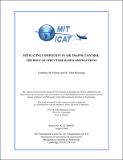| dc.contributor.author | Hansman, R. John | |
| dc.contributor.author | Histon, Jonathan M. | |
| dc.date.accessioned | 2008-08-29T18:43:58Z | |
| dc.date.available | 2008-08-29T18:43:58Z | |
| dc.date.issued | 2008-08 | |
| dc.identifier.uri | http://hdl.handle.net/1721.1/42006 | |
| dc.description.abstract | Cognitive complexity is a limiting factor on the capacity and efficiency of the Air Traffic Control
(ATC) system. A multi-faceted cognitive ethnography approach shows that structure, defined as
the physical and informational elements that organize and arrange the ATC environment, plays an
important role in helping controllers mitigate cognitive complexity. Key influences of structure
in the operational environment and on controller cognitive processes are incorporated into a
cognitive process model. Controllers are hypothesized to internalize the structural influences in
the form of abstractions simplifying their working mental model of the situation. By simplifying
their working mental model, these structure-based abstractions reduce cognitive complexity. | en |
| dc.description.sponsorship | FAA grants 96-C-001 and # 06-G-006. | en |
| dc.language.iso | en_US | en |
| dc.relation.ispartofseries | ICAT-2008-05; | |
| dc.subject | Training | en |
| dc.subject | Structure-based Abstraction | en |
| dc.subject | Structure | en |
| dc.subject | Cognitive Complexity | en |
| dc.subject | Air Traffic Control | en |
| dc.title | Mitigating Complexity in Air Traffic Control: The Role of Structure-Based Abstractions | en |
| dc.type | Technical Report | en |
